Together. Apart.
The extraordinary challenges of the COVID-19 crisis have coincided with an unparalleled period of productivity at Space Syntax. Breakthroughs in urban modelling have led, for example, to innovations in land value forecasting and new services in sustainable urban mobility. The experience of practice has also forged new relationships with clients and professional partners.
As the fundamental purpose of buildings and cities is questioned by those commissioning, investing in and, ultimately, occupying them, we believe more than ever that our vision of “thriving life” creates a common purpose. Please read on to see some of our recent highlights.
Stay safe and well, and do connect with us if you think we might help.

Tim Stonor
Managing Director
As we come out of lockdown, towns and cities are rethinking the way people use them, prioritising walking and cycling over driving and, in some cases, public transport.
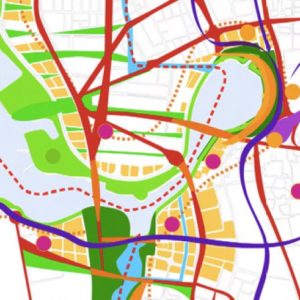
Space Syntax is supporting towns and cities worldwide with mobility planning tools that use a straightforward and affordable methodology to address the new need for physical distancing. First, we rapidly establish the “mobility hierarchy” of an urban centre, using Spatial Accessibility Models to identify the most convenient route networks for walking and cycling and, therefore, the place to focus investment in change.
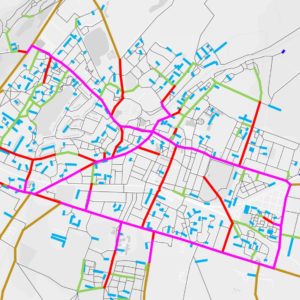
Next we measure the “mobility capacity” of the network under the new social distancing requirements. This helps to identify capacity pinch points and pathway overlaps that need special priority.
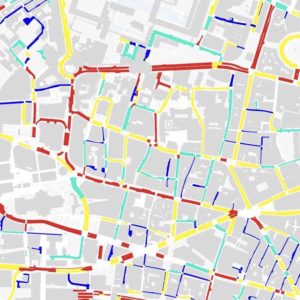
Our analysis drives the creation of “mobility strategies” for safe & comfortable transport. These strategies use evidence and analysis to rebalance street space to the needs of pedestrians & cyclists. In doing so, they address the challenges of climate resilience, public health & socio-economic inequality, with a robust vision for change.
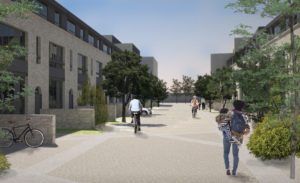
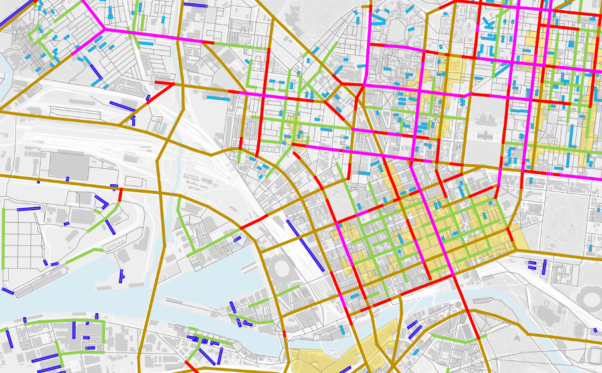
Working with the City of Melbourne, Space Syntax has created a modelling tool that measures the impact on land values of key urban design factors including spatial connectivity, land use attraction and transport infrastructure. The “Urban Value Model” demonstrates the benefits of a fine-grained street network, diversity of land uses and proximity of public transport stops.
The Space Syntax team worked with city planning and design officers, taking pre-existing datasets and supplementing these with a purpose-built “Spatial Accessibility Model” of Melbourne. As well as calculating key spatial parameters such as local/global accessibility, urban block size and street network density, the Spatial Accessibility Model provides a “data framework” that allows other datasets to be combined and simultaneously analysed.
“Urban Value Models bring a new level of rigour to the urban masterplanning process, connecting design to real estate economics and allowing the effects of design decisions to be measured quantitatively. This takes us beyond the hopes of professional guesswork that too often characterise our industry.”
Nora Karastergiou
Project director for the Melbourne Urban Value Model
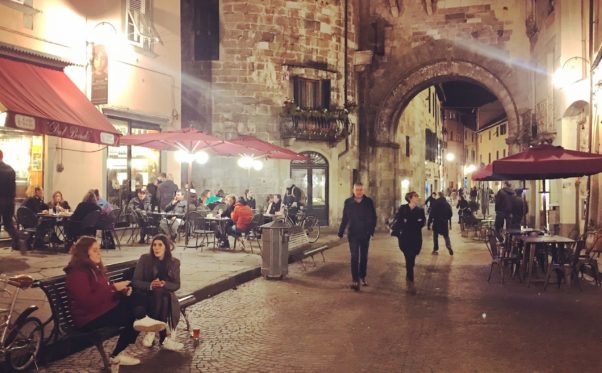
Space Syntax is partnering in an EU-funded research project to develop sustainable mobility strategies for towns and cities of all sizes. The findings of the “Sump-Plus” research project will help places address their differing mobility challenges, with a focus on low carbon solutions including walking, cycling and public transport. Working across six cities (Alba Iulia, Antwerp, Greater Manchester, Klaipeda, Lucca and Platanias) Sump-Plus is putting mobility where it belongs: at the heart of sustainable urban transformation.
The role of Space Syntax is to develop mobility assessment tools for the city partners that bring together data on spatial layout and land use patterns. The resulting “Integrated Urban Models” assist in the creation of sustainable mobility strategies. These models can be combined with qualitative assessments that identify the local issues that need to be addressed and the processes by which these might be achieved.
Ultimately, the Sump-Plus partnership will help urban places create context-specific mobility strategies, which respond to local parameters including size and available resources. Crucially, these strategies integrate across professional disciplines that are otherwise siloed: transport planning, urban design, landscape design, urban economics and health. By combining digital techniques with collaborative processes, the project aims to deliver an innovative approach to the challenge of sustainable mobility solutions.
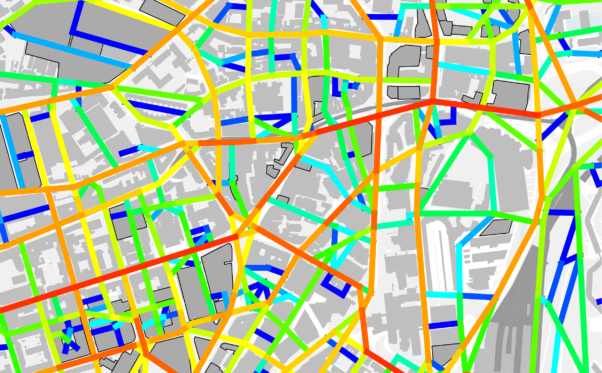
The UK government’s £1bn Future High Streets Fund aims to transform and regenerate high Streets across England, making them fit for the future. It will help revitalise local high streets and boost economic buoyancy in town centres where people live, shop, use services, and spend their leisure time. Space Syntax has been working with the City of Sheffield, supporting its successful initial bid to secure funding for improvements to Sheffield’s historic High Street and Fargate, its famous shopping street.
We are now assisting in the next stage of the bid, providing public realm design advice and modelling the pedestrian movement impacts of future development scenarios. Our input is the latest phase of a longstanding relationship with the City. Working across several different phases of the Heart of the City masterplan, Space Syntax is aiding in the transformation of the City Centre as a vibrant, mixed-use district that attracts more jobs, investment and visitors.
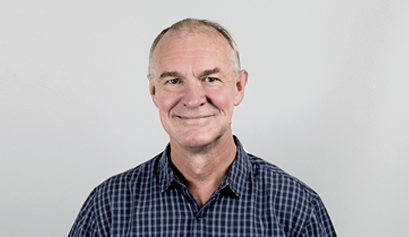
Alan Penn has been named as an advisor on the UK Government’s Scientific Advisory Group for Emergencies (SAGE), in response to the COVID-19 pandemic. Alan is one of the original pioneers of the “space syntax approach” and was a founding director of Space Syntax Limited in 1989. Today, he chairs the company’s Board of Directors, provides expert input to consulting projects and advises on the research and digital development strategy of the business.
SAGE is responsible for ensuring that coordinated expertise and technical advice from across the scientific spectrum is made available to government decision makers during emergencies. SAGE provides this support to the Cabinet Office Briefing Room (COBR) by providing unified scientific advice in non-technical language. Alan has joined SAGE’s Environmental Working Group, which identifies how environmental modelling, sampling and data analysis can play a part in comprehending the transmission of COVID-19, in an aim to understand the routes and factors of transmission.
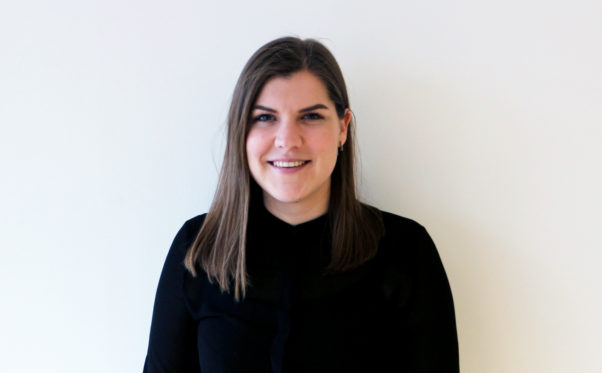
Alexandra joined Space Syntax in November 2019 as an intern and then in February 2020 took on the position of Consultant. She qualified as an architect in South Africa and practised there before moving to London to study the MSc in Space Syntax at the Bartlett, UCL. Alexandra’s research focused on the persistence of poverty in particular parts of South African cities.
She is currently working on Space Syntax’s 2030 Masterplan for Nur-Sultan, Kazakhstan.
Tim Stonor has contributed a chapter to a new book, Cities of Opportunities: Connecting Culture
and Innovation. Edited by Prof Jason Pomeroy and published by Routledge, Cities of Opportunities was launched earlier this year at the World Urban Forum in Abu Dhabi. In his chapter, “The science of street life and the rebirth of the boulevard”, Tim discusses the negative consequences of spatially fragmented urbanism – car dependency, low levels of physical activity and socio-economic isolation – and argues for a data-driven approach to future urban design, built around connected networks of slow, mixed use and moderately dense streets.
Tim argues that urban planners should use scientific techniques of observation, analysis and forecasting, learning from failed urban development as well as from successful places, to help deliver the United Nation’s Sustainable Development Goals. Specifically, he advocates for connected street networks, systems of neighbourhood centres, a diversity of public spaces and slow patterns of urban mobility based on walking, cycling and public transport. These, he says, are key to creation of a “people first” city, that supports interpersonal encounters, fosters serendipity and sparks the capacity for innovation that define the human species.
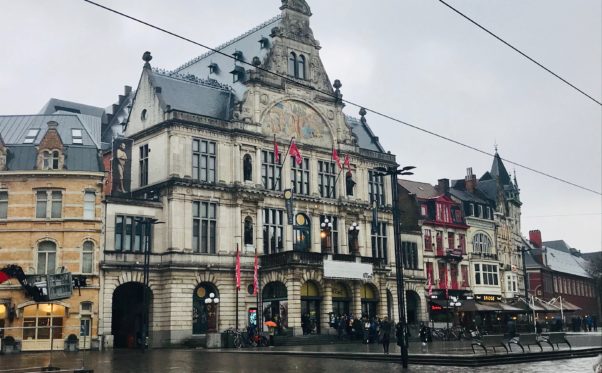
Anna Rose joined an interdisciplinary panel discussing the role that new theatre buildings can play in the public life of cities. She argued that well–designed theatres can address a number of urban objectives, supporting social cohesion by welcoming diverse audiences including ageing societies and young people from disadvantaged backgrounds.
In doing so, theatres can reach new audiences and justify their public funding. Cultural buildings should, Anna said, be open and accessible, providing unprogrammed spaces that people can freely occupy, engaging with new visitors through unpaid exhibitions and programmes, and providing glimpses of their back of house activities.
Anna was in discussion with Ina Karr (Theatre Lucern), Prof. Jan Kazardig (FU Berlin) and Daniel Rosbottom (DRDH Architects). The event was moderated by Joerg Jung.
Space Syntax provides spatial layout design services for theatres, museums and galleries that employ computer modelling tools to anticipate visitor behaviour patterns. Our portfolio includes the National Theatre, Royal Festival Hall and Royal Opera House in London.
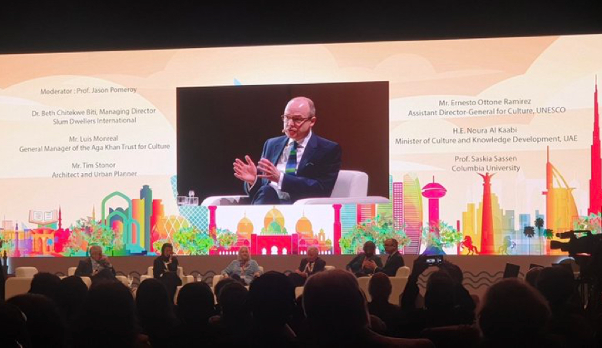
Tim Stonor and Eleri Jones attended this landmark event in February. Convened by UN-Habitat, the World Urban Forum has become the foremost international gathering for exchanging views and experiences on sustainable urbanisation. Tim spoke in the plenary panel on “Culture & innovation”, alongside HE Noura Al Kaabi, UAE Minister of Culture, Ernesto Ottone Ramirez of UNESCO, Prof Saskia Sassen of Columbia University, Luis Monreal of the Aga Khan Trust and Beth Chitekwe of Slum Dwellers International. The session was moderated by Prof Jason Pomeroy.
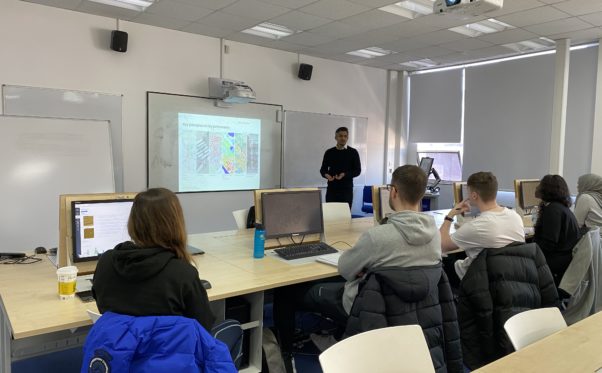
Abhimanyu Acharya taught a short course on space syntax as part of the University of Wolverhampton’s MSc in Building Information Modelling for Integrated Construction. The course combined presentations on space syntax theory and principles with workshops that gave students hands-on experience with the GIS-based methodologies we use in our practice. Students were then able to incorporate the training into their individual projects, which this year focused on redesigning the Wolverhampton City Centre.
https://www.wlv.ac.uk/courses/msc-building-information-modelling-for-integrated-construction/
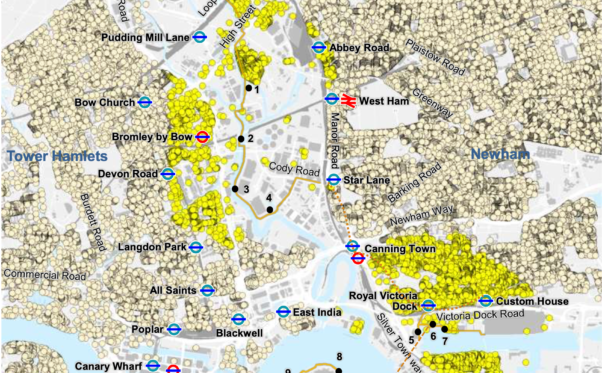
Space Syntax is delighted to be associated with The Line, London’s first dedicated public art walk, which is now a Finalist in the ULI Europe Awards for Excellence and has recently been listed in Condé Nast Traveller’s Best Walks in London. The route runs between the Queen Elizabeth Olympic Park and The O2, following the waterways and the line of the Greenwich Meridian.
Space Syntax is a Founding Supporter of the project and has contributed to the development of the concept since its initiation in 2015 by gallerist Megan Piper and the late Clive Dutton. We have advised on the route of The Line itself, the placement of artworks along it and the spatial connections into the neighbourhoods either side. In doing so, we have helped create an understanding of the contribution the project makes to the wider regeneration of this part of London.
‘The regeneration of London’s Docks and the surrounding area has long been hampered by a lack of connectivity both physical and psychological. The Line brilliantly delivers a thread that ties the area together – suddenly Greenwich Peninsula becomes part of a route that meanders up the Lea Valley to Stratford. It’s an art exhibition that does more than most – it recognises the importance of culture as a key part of city making; it encourages walking and cycling and it leads us to pieces of city that we might not otherwise discover. And it is accessible to all. It is a fine monument to the enthusiasm and curatorial skill of Megan Piper and an appropriate memorial to Clive Dutton whose planning vision we sorely miss.’
Peter Murray
Chairman, New London Architecture